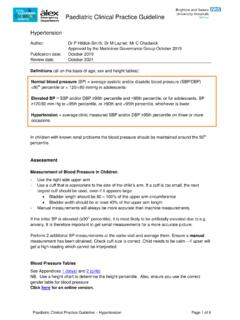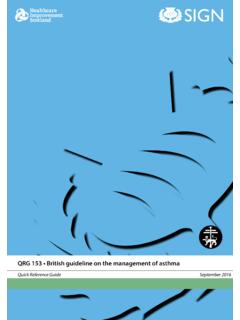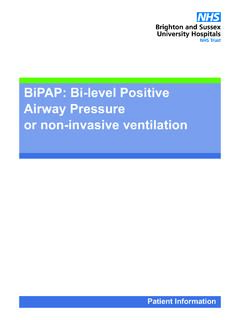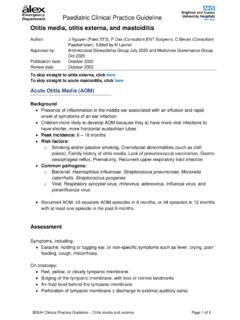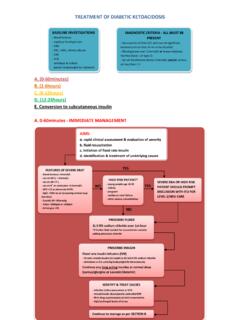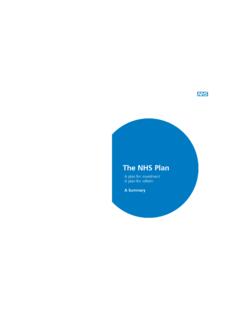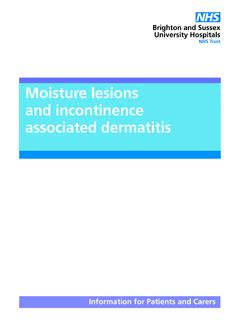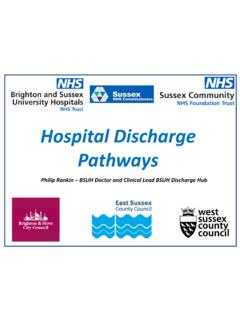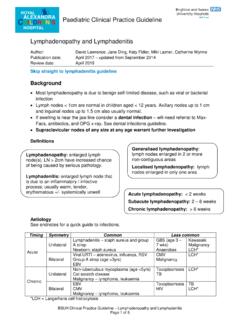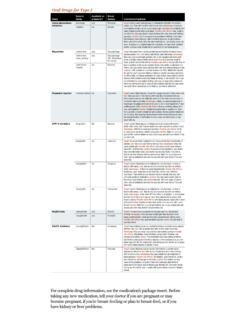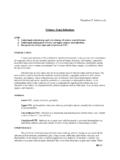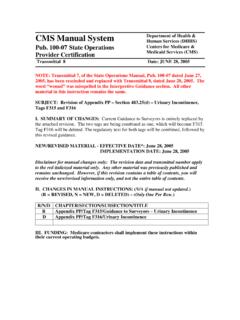Transcription of Lower Urinary Tract Symptoms (LUTS) - Royal Sussex …
1 2 Lower Urinary Tract Symptoms (LUTS)Department of UrologyPatient Information22 IntroductionThis information is for men who are troubled by Lower Urinary Tract Symptoms (LUTS).Healthcare professionals use the words Lower Urinary Tract Symptoms (or LUTS) to describe the problems they believe are related to the working of the bladder (which holds urine) and the urethra (the tube from the bladder to outside) through which urine passes when we are many causes of these Symptoms and we will investigate to find out the enlargement secondary to benign prostatic hyperplasia (BPH) is a major cause of LUTS, as a result of obstruction at the exit of the bladder.
2 Other urological conditions such as a tight or enlarged bladder neck, an overactive bladder, or a narrowing in the urethra known as a stricture may cause similar all LUTS are caused by a urological condition and other possibilities could involve heart, kidney or nervous system abnormalities. What can we do? Establish a diagnosis and provide information about your Symptoms and the treatment options available. Assist you in making an informed choice regarding the management of your Symptoms with your doctor or nurse can we do?2 What and where is the prostate gland?The prostate is a small gland, about the size of a walnut, which lies just below the bladder and is only present in of the main functions of the prostate is to squeeze fluid into the urethra as sperm move through during fluid contains nutrients for the sperm, activates them and has other roles in sexual reproduction.
3 The prostate provides much of the volume of the LUTS a common problem? Lower Urinary Tract Symptoms (LUTS) are a very common problem that affects men as they get older. In Europe 14 per cent of men in their forties experience Symptoms and this increases to 40 per cent in men over sixty. The Cause and how does an Obstruction occur?One cause of obstruction can be from the prostate gland enlarging. As men age their prostate becomes enlarged 3 What and where is the prostate gland?The cause and how does an obstruction occur?Are LUTS a common problem?KidneyUreterBladderProstateUreth raProstateUrethraBladderand this condition is known as benign prostatic hyperplasia (BPH) the exact cause of which is unknown.
4 The condition is associated with hormonal changes that occur as men age. The testes produce the male hormone testosterone, which is converted to a more active form dihydrotestosterone (DHT). High levels of dihydrotestosterone are produced in the cells of the prostate and cause prostate growth hyperplasia (enlargement). How and why levels of DHT increase remains a subject of research. As the prostate gland grows it can squeeze the urethra and the neck of the bladder can be tight or can make it more difficult for the urine to flow freely and the bladder works harder to force urine through the narrowed urethra. This leads to the bladder wall becoming thicker and more sensitive, and makes it more difficult for the bladder to empty completely.
5 LUTS can be divided into two groups according to its Symptoms :-Those that occur during the filling of the bladder known as storage Symptoms and those that describe the way the urine is passed, known as voiding Symptoms .The main storage Symptoms are:- Frequency describes the number of times you go to the toilet during waking hours. For men it is usual to go 4-8 times, although of course this depends on how much you drink. Nocturia means getting up at night to pass urine. This also becomes much more common as you get older and it is 45 normal for men over 70 to get up at least once. This will again depend on the timing of your fluid intake.
6 Urgency a sudden strong feeling which tells you to go now or you might leak urine . This becomes more common as we get older. Incontinence a term referring to the accidental leakage of urine. It can vary from a few drops to a flood. In older men, urge incontinence is the most common type seen. There is an urgent need to urinate but you leak before you can get to the main voiding Symptoms are:- Decreased stream the speed of flow of urine has decreased compared to when you were younger. This happens to all men to some degree Hesitancy when you get to the bathroom and you are ready to pass urine, nothing happens for a few seconds or even longer Intermittency a term meaning to pass urine in a broken stop/start stream rather than a continuous one Feeling of incomplete emptying feeling that you still need to pass urine again even though you have just tried to empty your bladder Dribbling There are three types of dribbling.
7 1 Incontinence or wetness occurring at any time as the bladder Terminal dribbling where the urine stream starts off reasonably strong, but slows to a dribble towards the end and therefore goes on and Post-micturition dribble, where you think you have finished, you dress yourself, walk away from the toilet and then leak some different types of dribble have different causes and therefore different types of causes of Nocturia may include: Drinking too much fluid before going to bed Reduced bladder capacity. As we get older our bladders tend not to store as much urine as they used to. Bladder retraining can help to increase the amount of urine the bladder can store Having a different body clock , which causes a normal daytime pattern to occur at night Diabetes, if it is not controlled.
8 This leads to sugar appearing in the urine, which stimulates extra urine to be produced If the bladder is unstable or irritated as a result of infection Swollen ankles and legs with excess fluid. At night when you lie down this excess fluid is reabsorbed into the blood stream and the kidneys then produce more are the Complications of BPH?BPH is rarely life threatening, however if left untreated it can lead to irreversible bladder or kidney damage. The bladder can become stretched and little pockets form in the bladder wall known as diverticular, these may hold stale urine, which can then become infected. Back pressure may also be exerted onto the kidneys as the bladder is unable to empty, it becomes swollen causing a rise in pressure and the urine can be transmitted back up to the men find they are suddenly unable to pass urine to empty their bladder and have severe pain and discomfort in the Lower abdomen; this is referred to as Acute Urinary Retention (AUR).
9 If this situation occurs you need to attend a hospital s emergency department to have a catheter inserted. A catheter is a slim plastic tube that is gently passed through the urethra to drain urine Symptoms that can develop over time include Urinary Tract Infections (UTI s) bladder stones and GP or consultant will refer you to a Prostate Assessment Clinic or a Lower Urinary Tract Symptoms (LUTS) clinic for an assessment. There you will be seen by a specialist nurse or a doctor, either at the Princess Royal Hospital or at the Royal Sussex County are the complications of BPH?Diagnosis8 The AssessmentDuring the assessment a number of tests may be performed, these may include; A urine test to check for infection and blood A blood test to assess how well the kidneys are working and a PSA blood test.
10 Prostate Specific Antigen (PSA) is a substance produced in the prostate gland and detected in the blood therefore a blood test can be taken to measure the is normal for men to have low levels of PSA in their blood; however, prostate cancer or benign (not cancerous) conditions can increase PSA levels. As men age, both benign prostate conditions and prostate cancer become more frequent. The most common benign prostate conditions are prostatitis (inflammation of the prostate) and benign prostatic hyperplasia (BPH) (enlargement of the prostate). There is no evidence that prostatitis or BPH cause cancer, but it is possible for a man to have one or both of these conditions and to develop prostate cancer as levels alone do not give doctors enough information to distinguish between benign prostate conditions and , PSA is not a specific test for cancer, and before you have the test you need to have discussed the implications of the results with your GP, doctor or nurse specialist.
